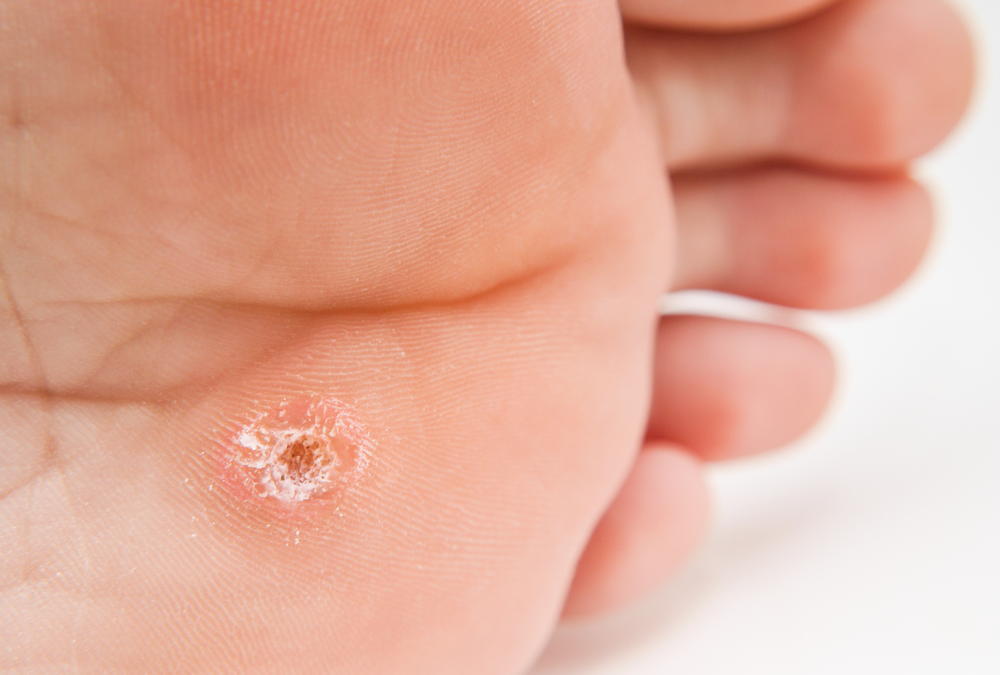The sole of the foot is strong and tough by nature, supporting you at every step. When growths develop on the bottom of your foot, you may have a callus or a wart. Eliminating the problem area as soon as possible is the key to minimizing discomfort and avoiding a worsening ailment. In order to properly treat this area, you must first identify a plantar wart vs callus. Our clinic in Victoria, BC can help identify and treat both.
Plantar Wart vs Callus: How to Tell the Difference
What Are Plantar Warts?
A wart is a small growth on your skin that commonly develops on the soles of your feet. They are caused by coming into contact with the HPV virus, and most are benign, although they can become uncomfortable. Coming in contact with the virus that causes warts can happen in a variety of ways, including walking barefoot in certain common areas, like communal showers or pools, or if you share personal care items with someone who already has warts.
While warts are not typically painful on their own, ones that develop on the bottom of the feet can become uncomfortable due to the pressure placed on them while walking. If your warts do not heal on their own, treatments to remove them through medication, surgery, or cryotherapy should be considered. Warts are an infection, and should be treated with care as to avoid worsening their condition.
What Are Calluses?
Calluses are thick, hardened patches of skin that are typically developed by constant pressure or friction. Calluses can become common on the bottom of the feet due to the pressure of shoes or prolonged standing or walking. Calluses don’t typically cause pain, but they can make walking uncomfortable. The easiest way to alleviate discomfort and rid your feet of calluses is to avoid applying pressure to the area by changing your footwear.
The most common areas of your foot that develop calluses are underneath your foot bones, either on the heel or ball of your foot. Upon examination, calluses appear as thick, toughened areas of otherwise normal skin. They typically develop as your body’s way of protecting itself from becoming rubbed raw by shoes or socks. They are not particularly painful, but may become uncomfortable to the touch if they grow too large, and can even affect the way you walk.
The Difference Between Warts and Calluses
Appearance
There are a few key distinctions between warts and calluses, and one such identifier is their appearance. It is possible that a callus can form over a wart, which can make either one difficult to differentiate from the other. But unless that is the case, the appearance of each one separately can usually be identified quickly.
The skin of your foot has many lines, similar to the palm of your hand. When you have a callus, the lines of your skin will continue to appear throughout the growth. Warts, on the other hand, do not have skin lines and will look like separate growths from the rest of your skin. Warts can have red or black dots in their centre, which is a tell-tale sign of infection.
Pain Levels
Calluses are less painful than warts, although warts are not painful in and of themselves. Calluses tend to only cause discomfort when they are directly pressed on, while warts can be painful when they are squeezed from the side. Warts on the feet may also cause itching, but are typically only uncomfortable because of the constant pressure applied to them due to their location.
Root Cause
While you may not know exactly when the problem began, thinking through your recent activities can help identify whether the growth is a wart or a callus. You are more likely to develop warts if you have recently walked barefoot in a communal area, such as a gym changing room or sauna. If you have been recently wearing footwear that has irritated your feet or felt uncomfortable, then the growth is more likely to be a callus.
Knowing these root causes may also assist you in avoiding warts or calluses in the future by helping you stay aware of these particular situations. By keeping your feet covered in public areas and avoiding shoes that cause irritation, you can help to limit the chances that you will develop either ailment.
Get an Assessment in Victoria, BC
It is not always possible for a patient to identify the difference between warts and calluses simply through the symptoms they are observing at home. Sometimes a more in-depth analysis is required. In these instances, our clinic can perform an assessment to determine which one you are experiencing and set you on the proper path for treatment and healing.
Instead of waiting to see if the problem goes away on its own, we can give you peace of mind that your callus or wart is treated properly and goes away for good. If the warts or calluses become very painful or begin to bleed, then come in for a consultation as soon as possible.
Treating Warts and Calluses At-Home
Most plantar warts and calluses go away on their own over time, but plantar warts do carry the risk of spreading to other parts of your feet if they are not treated properly. Never try to shave a wart or a callus yourself, as you could seriously damage your foot or cause an infection. Be courteous by keeping your feet covered in public places so as not to spread any potential virus to others.
The excess skin of a callus or wart can be buffed away with a pumice stone after soaking your foot in a warm bath to soften the affected area. Keep your feet moisturized so the skin will stay soft and pliable. Over-the-counter topical medications with salicylic acid can work to gradually slough off plantar warts. Be sure to wear shoes that give your feet room to breathe, or add shoe inserts to alleviate some of the pressure from your soles.
When to Seek Professional Help
When warts and calluses do not resolve on their own, or when they continue to develop in a way that seems abnormal, then seeking professional help may be necessary. Bleeding, drainage, and the presence of pain without added pressure are all signs that immediate attention is needed, regardless of whether the area in question is a callus or a wart.
If the lesion continues to grow or does not improve with at-home remedies, then it is time to book a consultation. Continuing to treat a worsening callus or wart at home can cause increased infection or pain. In rare cases, lesions that initially appear as a wart may actually be a sign of something more serious and must be evaluated.
When our feet experience discomfort, it can affect every aspect of our lives. Although they may look similar, warts and calluses require different treatments. They can be difficult to tell apart, but a quick diagnostic from our team will set you on the road to recovery. Contact us today at Island Foot Clinics for a thorough consultation and treatment plan. Our goal is to get you feeling your best and back on your feet in the safest way possible.

